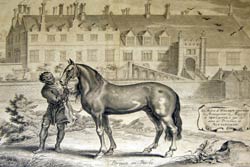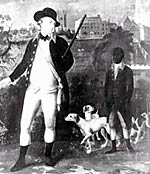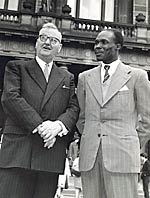
Overview
 Equestrian groom at Welbeck
Abbey, 1657
Equestrian groom at Welbeck
Abbey, 1657Nottingham has long associations with the black community. In the Nottingham Journal, of Friday 8 August 1834, one week after the introduction of the Abolition of Slavery Act 1834, the paper reported that there had been numerous services of thanksgiving held in the Wesleyan Methodist chapel, Bingham, Wesleyan chapel, Stapleford, Methodist New Connection chapel, Stapleford, Wesleyan Methodist chapel, Eastwood, Halifax Place chapel, as well as Friar Lane chapel, Baptist chapel, George Street and the Independents on Friar Lane and St James Street, Nottingham. Prayers had been said and hymns sung as well as providing an evening party resplendent with plum cake and jubilee wine.
The earliest known Nottingham reference to a black person was the baptism of John Americanus, a blackamoore, baptised in parish of Newark on 30 March 1645. There is an engraving ‘Paragon un barbe’ of a black man holding a horse outside of Welbeck Abbey dated 1657. This may have been the equestrian groom for the 1st Duke of Newcastle, William Cavendish.
The next record is that of a black man living in Clifton in 1685. The seventeenth century document states, “Joseph, commonly called the ‘Black Prince’, a Negro, who was converted to the Christian faith in 1685, is also remembered here.” It is alleged he grew to the height of seven feet and this is recorded in Clifton Church’s porch. It appears that he was brought up in the Clifton family. On 12 January 1771 George Pollidore, a ‘Negro, was baptised at St Nicholas’s church. On 3 February 1805 Simon Edward Derby (a ‘black’) was recorded in the St Mary’s workhouse.
 George Africanus and his master
George Africanus and his masterHowever, the first black man known to have lived in Nottingham was George Africanus. He was born in Sierra Leone and came to live with a family at Molyneux House, Wolverhampton where he rose to the position of manservant and was taught to read and write and subtract. Slavery was coming to and end and the family paid for George to learn a trade as a brass founder. In 1784 at the age of 21 years he completed his service with the family, left Wolverhampton and came to live in Nottingham. He married Ester Shaw , a 20 year old local girl on 2 August 1788 at St Peter’s Church, at the age of 25 years. The couple had six children, only one of whom survived into adulthood, and lived on Chandlers Lane in the centre of the town. He worked as a brass founder and his wife as a milliner, working from home and looking after the children. He went on to practice several other trades. In 1820 he was the keeper of the ‘Register Office of Servants’, an employment agency which placed servants with high class families in Nottingham. He also owned property; the poll book of 1818 showed that he was a freeholder, which meant he was eligible to vote in parliamentary elections. He was also a member of the Watch and Ward Register in 1812 and 1816 which stated he could be called to assist in law and order duties. He died aged 71, on May 24, 1834 and was buried in St Mary’s churchyard.
Newstead Abbey, ancestral home of Byron, had many links with Africa. In 1859 the house was sold to the Webb family, William Webb was an explorer in Africa and a friend of missionary David Livingstone. After Livingstone’s death in 1873his African friends, Susi and Chuma travelled to Newstead Abbey to meet the Webb family.Mr Webb’s hunting expeditions in Africa provided animal skins and horns to decorate Newstead Abbey. (see “Livingstone and Newstead” (London, 1913) by A.Z.Webb Fraser )
In the Nottingham Journal 9 October 1773 there is an advert by a black person looking for work, “Universal office of intelligence. A black about 17 years would be glad to wait on any gentleman’s family; has a character from his last place.”
‘Revelations of Nottingham’, a Victorian book placed the black community in the section above “low society” which reflected their negative attitude towards “freed blacks” in England during the late 19th century.
There were no doubt other black people in Nottingham through the eighteenth and nineteenth centuries. In 1885 there is a photograph of a black member of the Nottingham Cycling Club. However, the next real record of their presence was in the twentieth century. In the post-war era, men who had served in the armed forces began to settle in the city. One such Jamaican was Eric Irons, who became the first black magistrate in 1962. His story is similar to many black people who came to Nottingham after the war. In 1944 he was recruited into the RAF in Jamaica and in 1945 visited RAF Syston but was based at Little Rissington, Bedford. From this visit he decided he wanted to come and live in Nottingham. He extended his service with the RAF for a further 5 years and married a local girl from Nottingham and settled on Pennyfoot Street. The only other black families lived in the same neighbourhood so it was natural for others to join them. There were two other West Indian families living in Nottingham as well as two doctors both of whom had European wives.
Because of the prejudices shown towards the black people in the 1950s Mr Irons set up the first community group the Colonial Social and Sports Club, at his own house. The attraction of Nottingham was that many people had spent some time in the town during their time in the armed forces and they returned to find work after the war. The opportunities were in mining, textiles, hospitals and British Celonese. Irons began work at Chilwell Ordnance Depot in the offices in 1952. Only a handful of black workers were employed at the depot. Irons began to take up the issue of discrimination. Through his work more were taken on both in the depot and in other employment. Many companies were reluctant to take on black employees for a variety of reasons – such as not having the paperwork for certain skills. Trade Unions were reluctant to take on uncertified skilled workers at places such as Players, Raleigh and Boots and the Nottingham City Transport. Through the help of Jack Charlesworth, Secretary to the Nottingham and District Trades Council, matters were resolved in relation to skilled workers.
During the 1950s, a representative of the Jamaican Government, based at the Colonial Office, Ivo De Souza visited Nottingham to see how immigrants from Jamaica were being assimilated in the city.
When the first groups of immigrants arrived in Nottingham it was because of the supposed employment opportunities available. One area was the textile trades but they had a poor record of employing black people. Eric Irons took up the issue with the Nottingham and District Trades Council. It was claimed that black people lacked the skills needed within this type of trade. Through negotiations and talking, some of the problems were resolved.
In 1955 Eric irons went onto the Consultative Committee for the welfare of black people, which was set up by a Council of Church/Social Services and the Colonial Social and Sports Club. The idea was to discuss prejudice and local issues. One of the problems lay in the fact that no black people were taking advantage of educational courses particularly those held by the WEA.
During the 1950s Britain was in a period of reconstruction and needed labour. This was never more so than in hospitals that were short of staff; in response to this shortage, the British Government recruited directly from the Caribbean or people joined the Health service after arriving in this country. Working hours for nurses were long, conditions poor with low pay. Nevertheless many came to Nottingham and worked in the numerous hospitals around the county. One hospital which had a large number of black nurses was Saxondale Hospital near to Radcliffe on Trent. We are fortunate to have a publication “Nursing lives of black nurses in Nottingham”, which has captured the highs and lows of black women coming to England to join the National Health Service. It was not just women who went into the Health Service, Oscar Smart became the first State Registered Nurse to be trained at Nottingham City Hospital.
In 1958 Nottingham was the scene of one Britain’s most bitter and ugliest racial conflicts. Animosity began between the black and white communities in the St Anns district and on 23 August simmering resentment erupted in a scuffle in a local pub and escalated into fighting involving 1500 people. Widespread media coverage spotlighted the problem and the following week a crowd of nearly 4,000 whites gathered seeking revenge. The black community stayed indoors and the whites fought among themselves. In the aftermath the local Labour party voiced the concerns of the black community who felt that the police had acted in an unfair and prejudicial manner.
There was similar flare up of trouble in 1981, not only in Nottingham but nationwide. In July underlying tensions flared up in the Hyson Green area and there were several confrontations between black and white youths and the police. Peace was restored but not before much damage had been done to the Hyson Green flat complex.
 Eric Irons.
Eric Irons.Aside from these disturbances Nottingham can boast several famous black citizens. Gary Sobers, already world number one cricketer and captain of the West Indies team, joined Nottinghamshire and captained them for 5 years. The footballer Viv Anderson, from Clifton joined Forest in 1974 and was in the England squad in Czechoslovakia. Justin Fashanu, former under 21 England player, joined Nottingham Forest football club at a cost of £1m in August 1981. Sharon Gibson, javelin thrower who beat Fatima Whitbread in 1990 and Tessa Sanderson in 1991 was also from Nottingham. More recently Jermaine Jenas has played for Nottingham Forest and Tottenham Hotspur. Other well-known black people are, Eric Irons, the first black magistrate in 1962; Tony Robinson, first black Sheriff of Nottingham; Des Wilson, first black Lord Mayor; Dr Hillgrove Robinnson, Medical Officer of Health for Arnold and Carlton for 15 years.
The Afro-Caribbean population in Nottingham itself grew from 23 in 1931 to nearly 4,000 in 1991. In the 2001 census the black population only made up about 0 .5% of the total population of 74, 8510. Since the 1950s the immigrant population and their British-born children have made many valuable contributions to the economic, social, cultural and political diversity of Nottinghamshire. Many women began work in the hospitals in Nottinghamshire; there are festivals celebrating their culture. Today the black presence in Nottingham is celebrated in a variety of ways and they form an integral part of the community in Nottinghamshire.
This entry covers only the Afro-Caribbean community. It is hoped that eventually other groups will be considered.